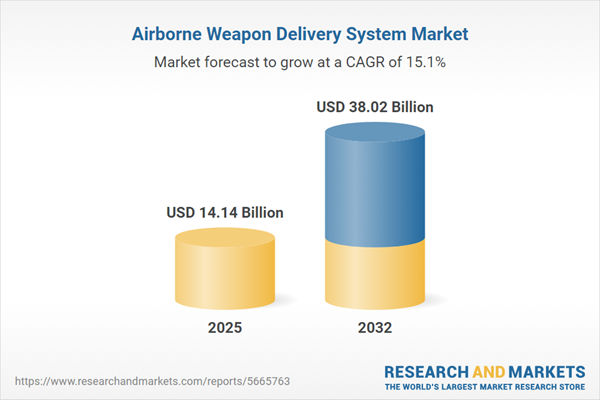Speak directly to the analyst to clarify any post sales queries you may have.
Airborne weapon delivery systems play a critical role in modern defense strategies, empowering military organizations to enhance interoperability, agility, and mission readiness in the face of rapidly evolving security challenges. As global defense priorities shift, decision-makers in the sector benefit from intelligence that informs effective procurement and technology integration across diverse operational environments.
Market Snapshot: Airborne Weapon Delivery System Market
The airborne weapon delivery system market is witnessing accelerated advancement, driven by robust investments in next-generation munitions, adaptable aircraft platforms, and the integration of sophisticated digital solutions. From 2024 to 2032, the sector is forecasted to achieve a compound annual growth rate (CAGR) of 15.13%. This upward momentum is influenced by growing technology adoption across defense organizations, an increased demand for multi-role capabilities, and the deployment of interconnected digital systems that support real-time decision-making and mission coordination. These advancements position defense units to manage sophisticated threats and efficiently address evolving battlefield requirements.
Scope & Segmentation of the Market
- Weapon Types: GPS-guided, infrared-guided, and laser-guided munitions provide precise targeting solutions in complex operational conditions. Categories also include unguided bombs, air-to-air and air-to-ground missiles, anti-ship weapons, gun turrets, and rocket pods, allowing for expanded aerial mission effectiveness.
- Platform Types: Fixed-wing aircraft, rotary-wing platforms, and unmanned aerial vehicles are leveraged for different mission objectives, spanning from reconnaissance and surveillance with micro-UAVs to large-scale strategic deployment assets used for wide-area operations.
- Delivery Modes: Free-fall mechanisms and guided munitions—relying on GPS, inertial, or laser navigation—cater to diverse mission profiles, enhancing precision and adaptability in dynamic threat landscapes.
- End Users: Air force, army, navy, and special operations units utilize these systems to achieve tactical flexibility and ensure high-performance outcomes in joint or coalition missions.
- Regions: The market comprises North America, Latin America, Europe, Middle East and Africa, and Asia-Pacific. High levels of investment in technology and supply chain localization are especially notable in China, India, Japan, and Australia, supporting regional defense autonomy and readiness.
- Leading Providers: Industry leaders such as Raytheon Technologies Corporation, Lockheed Martin Corporation, Northrop Grumman Corporation, The Boeing Company, MBDA SAS, General Dynamics Corporation, BAE Systems plc, L3Harris Technologies, Leonardo S.p.A., and Thales S.A. advance innovation and reinforce industry standards. Strategic collaboration among these players fosters continuous development and competitive differentiation.
Key Takeaways for Senior Decision Makers
- Sensor fusion and artificial intelligence are reshaping situational awareness, giving command centers improved data accuracy for real-time operational decisions in multifaceted environments.
- Modular system designs promote easier technology updates, enabling military forces to quickly align their capabilities with emerging mission scenarios while reducing system downtime.
- Enhanced interoperability between platforms and services facilitates collaborative missions, improving coordination in both national and multinational defense operations.
- Strengthening supplier partnerships and integrating emerging technologies can help reduce operational disruptions, providing resilience during changes in policy or geopolitical shifts.
- Diversified supply chain strategies allow organizations to respond more effectively to regulatory or market fluctuations, ensuring continuity in mission-critical system availability.
- The integration of manned and unmanned assets across theaters increases tactical flexibility and broadens operational response options for commanders.
Tariff Impact: Supply Chain Adaptation in 2025
Adjustments to U.S. tariffs on aerospace and defense components are causing defense contractors to reshape procurement and sourcing strategies. Emphasis on advanced supplier management, alongside prioritizing domestic and allied partners, has become essential to maintain supply chain stability. This shift may also necessitate reevaluation of logistics, with flexible sourcing models and heightened oversight supporting uninterrupted delivery of key defense capabilities across volatile regulatory and supply environments.
Methodology & Data Sources
The findings draw on a combination of primary insights from industry experts and extensive secondary research. Data triangulation and scenario-based modeling underpin the recommendations, ensuring the analysis is relevant for executives prioritizing risk mitigation, compliance, and forward-looking investment strategies within the airborne weapon delivery system market.
Why This Report Matters
- Enables defense leaders to confidently strategize advanced airborne weapon system deployments and optimize supplier engagement methods.
- Supports procurement teams in addressing technical compliance and managing operational risks in high-stakes, global defense environments.
- Clarifies market trends impacting long-term capability development, encouraging resilient investment and sustained operational excellence.
Conclusion
This report empowers senior defense professionals to make informed procurement and strategy decisions, equipping organizations with proven solutions that align with the pace and complexity of modern operational demands.
Additional Product Information:
- Purchase of this report includes 1 year online access with quarterly updates.
- This report can be updated on request. Please contact our Customer Experience team using the Ask a Question widget on our website.
Table of Contents
3. Executive Summary
4. Market Overview
7. Cumulative Impact of Artificial Intelligence 2025
Companies Mentioned
The companies profiled in this Airborne Weapon Delivery System market report include:- Raytheon Technologies Corporation
- Lockheed Martin Corporation
- Northrop Grumman Corporation
- The Boeing Company
- MBDA SAS
- General Dynamics Corporation
- BAE Systems plc
- L3Harris Technologies, Inc.
- Leonardo S.p.A.
- Thales S.A.
Table Information
| Report Attribute | Details |
|---|---|
| No. of Pages | 193 |
| Published | October 2025 |
| Forecast Period | 2025 - 2032 |
| Estimated Market Value ( USD | $ 14.14 Billion |
| Forecasted Market Value ( USD | $ 38.02 Billion |
| Compound Annual Growth Rate | 15.1% |
| Regions Covered | Global |
| No. of Companies Mentioned | 11 |









